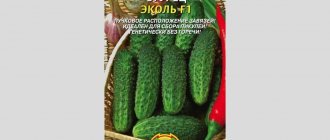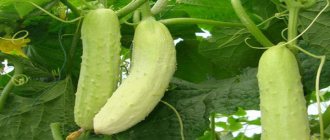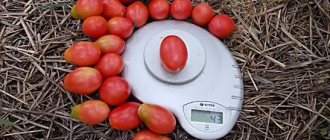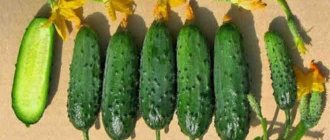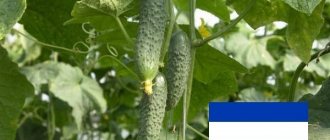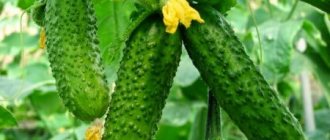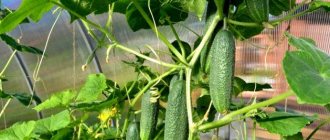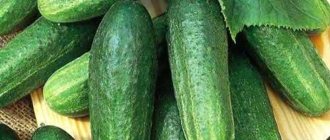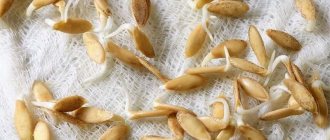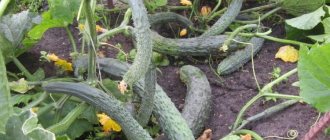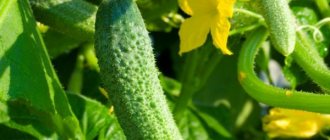The Parisian gherkin variety of cucumbers is highly valued for its delicious taste and small size of fruits, excellent for pickling and preservation. Registered in the State Register in 2006 by the originator - agro (Vereya village, Moscow region). It is recommended for cultivation in private farms in open ground conditions of the Central and Central Black Earth regions.
The variety is considered a prominent representative of classic pickling cucumbers in the so-called Russian shirt - large-tubercular and black-thorned
Due to the high adaptability of the variety to the soil and climatic conditions of the central regions of Russia, “Paris Gherkin” is very popular among gardeners in the middle zone, and has also become widespread in Ukraine.
Description of the Parisian gherkin variety
Cucumbers of the Parisian Gherkin variety are a mid-season variety. Ripening occurs in 40-45 days. Grown in the central parts of Russia. Suitable for open and closed ground.
The leaves are large, dark green, the flowers are predominantly female, yellow, bell-shaped
The bush is indeterminate, produces a moderate number of vines. Not many side shoots are formed. Fruits are formed along the entire length of the vines. The leaves are large, dark green. The flowers are predominantly female, yellow, and bell-shaped.
Zelentsy grow small - 6-8 cm, weighing 70-90 g. They are spindle-shaped in shape. The color is bright green with light stripes. The skin is covered with large pimples and black spines. The taste is pleasant, cucumber, without bitterness.
Interesting!
To get the harvest 1-2 weeks earlier, you need to grow the Parisian gherkin cucumber in a greenhouse using the seedling method.
Zelentsy grow small - 6-8 cm, weighing 70-90 g
Characteristics of the Parisian gherkin
Also check out these articles
- The best winter pear varieties
- Cucumber variety Gunnar F1
- Plum variety Angelina
- Winter wheat varieties
Parisian gherkin cucumbers have many advantages, but also have some disadvantages.
- Requires pollination by bees.
- Taste without bitterness. This is a universal type variety. Zelentsy are suitable for fresh consumption, pickling and canning.
- Resistance to powdery mildew and downy mildew is noted.
- The variety is not afraid of drought.
- Productivity is high. From a square of plantings you can harvest about 5 kg of cucumbers per season.
The Parisian gherkin variety needs pollination by bees.
- Harvest of commercial quality.
- Zelentsy can be transported over long distances.
Interesting!
The best predecessors of cucumbers on the site are tomatoes and legumes.
Advantages and disadvantages
- Gardeners who have already had experience cultivating the hybrid Parisian gherkin note the following advantages:
- high level of productivity;
- excellent taste and commercial qualities of cucumbers;
- early ripening;
- drought resistance;
- uniform fruiting;
- the ability of fruits to tolerate transportation well;
- strong immunity to many diseases;
- small fruit size, which is good for canning.
- The disadvantages include:
- low level of commercial output;
- tendency of fruits to barrel (overgrow);
- the need for mandatory garter.
Features of planting cucumbers
In the central and especially northern regions, it is recommended to grow Parisian gherkin cucumbers using the seedling method. But if the garden is located in a warm, southern region, where summer comes early, then you can simply sow the seeds in open ground, they will have time to germinate and produce a harvest on time. The planting location is chosen to be sunny, with light soil. The land should not be swampy. In order for the seeds to sprout faster, they must be treated in advance in a solution of potassium permanganate, and then also soaked in water for 1-2 days so that the seeds germinate.
In the central and especially northern regions, it is recommended to grow Parisian gherkin cucumbers using the seedling method
Sowing seeds for seedlings begins around April. It is grown in peat cups or a similar container so that the seedlings can be immediately planted in the ground with the cup. Planting of seedlings in a permanent place is carried out at the age of 20-25 days, when the sprouts already have 3-5 true leaves.
Important!
If the seeds have an atypical color (bright orange, pink, green or something like that), this means that they have undergone special treatment against diseases or pests. Such seeds cannot be soaked or germinated in advance!
Sowing seeds for seedlings begins around April
Seeds are sown in open ground in May or June, when the ground warms up to +15...+20 degrees. The land is fertilized in advance. It is advisable to add peat, humus, sand and mineral fertilizers to it, then the seeds will sprout and grow faster. Cucumbers are sown to a depth of 2 cm. The seedlings are planted so that they no longer need to be replanted or thinned out. After planting, it is necessary to water the soil and mulch it with peat on top.
Basic requirements for sowing
For beds with cucumbers, choose a sunny, fertile area; the plants do not do well in heavy soils.
Important: if a package of seeds is labeled “coated” or “granulated,” this means that they have been treated with pest protection and a growth stimulant. Such seeds germinate better and are more suitable for open ground.
See also
Description and characteristics of Libella F1 cucumbers, cultivation and care
Read
Landing dates
When sowing in greenhouses, cucumbers should be planted in the 1st-2nd decade of May, when planting in open ground - in the last ten days of May, early June.
The fruit ripening period is 40-45 days from the moment of emergence.
Selection and preparation of a site
For cucumbers, choose open sunny areas, richly fertilized with organic matter. No more than 3-4 plants are placed per 1 square meter. To make it easier to care for the plantings, they are tied to trellises. For a better harvest, you should form a high bed.
Planting cucumber seeds
Granulated seeds do not require additional processing; they are sown immediately in heated soil or in peat cups to be placed on the garden bed without replanting the sprout, since cucumbers do not tolerate replanting very well.
If the seeds were not purchased, but were prepared independently (this is possible for this variety), they should be calibrated (pour the seeds into a container with water), a large seed with good characteristics will sink to the bottom of the container, empty specimens will float up.
Then the selected seed must be soaked in a solution of potassium permanganate or salt for 12 hours, and then dried. In order for cucumbers to germinate well, they are sometimes placed in wet gauze until the first sprouts appear. Then the seeds are planted in containers with soil, which are covered with glass or film and placed in the sun, usually on a windowsill in an apartment. After two pairs of leaves appear, the seedlings are placed in a greenhouse or open ground.
The best predecessors of cucumbers are tomatoes and legumes.
Caring for cucumbers Parisian gherkin
We recommend reading our other articles
- Tomato Polbig F1
- Pruning roses
- Potato variety Sineglazka
- Cherry jam
The Parisian gherkin cucumber is easy to care for.
- The Parisian Gherkin cucumber needs regular watering, every 5 days. Carry out the procedure in the morning or evening, with warm water. Each adult plant should consume about 7 liters of water.
The Parisian gherkin cucumber needs regular watering, every 5 days.
- Weeding is done after each watering, when the water is absorbed. This is necessary so that the soil does not form a dense crust and a sufficient amount of oxygen reaches the roots.
- Parisian gherkin cucumbers need high-quality support. They are grown on trellises or similar supports.
Important!
When planting early, you should make sure that the cucumbers do not freeze at night, otherwise development will slow down. If there is a threat of cold weather, it is worth covering the plantings with film, making an impromptu greenhouse at least for the night!
- When growing in a greenhouse, it is important to ensure that bees can enter the greenhouse during pollination. Otherwise, you will have to carry out pollination yourself.
- Feeding is done several times a season. The first time this is necessary before flowering. In order for the plant to grow enough greenery, it is necessary to add nitrogen fertilizers (urea, chicken manure) to the soil. Then fertilizers are applied every 2 weeks, but superphosphate, wood ash or humus solution are added.
If there are a lot of weeds on the site, they will interfere with the development of cucumbers and spread diseases and pests, so it is advisable to pull them out as they appear.
Parisian gherkin cucumbers need high-quality support
Agrotechnics of cultivation and care
Growing the Parisian gherkin cucumber is possible in 2 ways - by sowing seeds in the ground and by obtaining and planting seedlings. According to the timing, this variety can be sown in the ground:
- in polycarbonate greenhouses - in the 1st decade of May;
- on beds protected with film or lutrasil - in the middle - end of May;
- in open ground without shelter - in the 3rd decade of May.
But these are only approximate dates; in fact, you need to sow the seeds when it becomes warm enough so that the seedlings do not die from the cold snap.
We recommend reading
How can you control cucumber pests in greenhouses and open ground?
Description of symptoms of cucumber disease, control methods
Recipes for preparing a solution for cucumbers based on iodine for feeding
Rules for growing cucumbers in open ground
Seed material for seedlings is sown approximately 1 month before the planned date of planting it in the ground. Parisian gherkin seeds purchased in industrial packages are not processed, but those collected from their own cucumbers are prepared for sowing. They germinate well, but in order to germinate faster, they need to be pickled in potassium permanganate for 30 minutes, washed in clean water, and then soaked for 1 day in warm water or in solutions of growth stimulants prepared according to the manufacturer’s instructions. After this, the swollen seeds are ready for sowing.
They are sown in individual containers: plastic or peat cups, film rolls or cassettes. All this is filled with universal soil for seedlings, 1 seed is sown in each container, watered and sprinkled with the same soil on top.
The technique for growing Parisian gherkin seedlings is standard:
- water it as the top layer of soil dries;
- fertilize with solutions of complex fertilizers, first when the cucumbers reach the stage of 1-2 true leaves, and then again after 2 weeks;
- provide lighting for at least 10-12 hours (if necessary, use phytolamps);
- harden 1-1.5 weeks before planting it in the ground.
The finished seedlings are planted in beds according to a pattern of 30 cm in a row and 50 cm between them.
Caring for cucumbers of this variety is also no different from caring for many other varieties of this crop. They are watered, loosened, fed, and harvested.
For irrigation, use warm, chlorine-free water. Irrigation is carried out in the mornings and evenings; watering during the day is not recommended. The frequency of watering is moderate at the growth stage of the bush, intensified with the beginning of flowering. After each irrigation, be sure to loosen the soil to prevent a crust from forming.
Cucumbers are fed throughout the growing season. The first fertilizing is done when the plants that are sown in the ground with seeds have 2 true leaves. Those that are planted in the ground with seedlings are fertilized for the first time 2 weeks after planting. The following procedure is carried out before flowering, 3 and 4 - when the cucumbers bear fruit en masse. They use organic matter - humus or manure (fresh), diluting it in a concentration of 1 to 10, ash or fertilizers containing basic nutrients, complex fertilizers with microelements.
The resistance of plants of this variety to common cucumber diseases allows, in most cases, to refuse treatment with agrochemicals. Often, preventative treatment with folk remedies is enough to prevent infections. This makes the product environmentally friendly.
Parisian gherkin cucumber bushes need to be tied up and shaped. To do this, install supports in the row and tie the plants with twine. Distributed on a trellis, they are better ventilated and illuminated, which has a positive effect on productivity. In addition, greens are much easier to collect, because they are located in plain sight, you don’t need to look for them, as happens if cucumbers grow in a horizontal position, they remain clean and do not get splashed with dirt when watering or raining.
Parisian gherkin cucumbers are harvested every day. All greens that have reached the characteristic size for the variety are picked off. They are then sent for processing, sale or storage. To store small volumes of gherkins, use a refrigerator; for large volumes, use a cold cellar. You can keep them there in perforated plastic bags or simply in small boxes.
Diseases and pests of the Parisian gherkin
Parisian gherkin cucumbers are resistant to powdery mildew and downy mildew, so if grown properly, problems with these diseases do not arise. But this does not mean that this variety is not affected by anything at all. Among the most common problems, only two ailments need to be highlighted.
- Cucumber mosaic appears as yellow or white spots on the leaves. The leaf blade becomes very thin and growth slows down. Scourges, leaves, cucumbers become deformed and lose their presentation. It is impossible to save cucumbers from this scourge. They need to be torn out, burned, and the ground disinfected with a bleach solution.
- Bacteriosis manifests itself in brown spots on cucumber leaves. Bushes can be cured by spraying with Bordeaux mixture.
Diseases and pests of Parisian gherkin cucumber
As for pests, gardeners most often complain about aphids and sprout flies.
- Aphid . If aphids appear on cucumbers, the plants must be sprayed with an infusion of garlic, red pepper, mustard or a similar folk remedy. If this does not help, you can use the insecticide “Intavir” or “Fitoverm”.
- Sprout fly . If a sprout fly is noticed, it is necessary to treat with the Fufanon insecticide.
It is necessary to remember that cucumbers growing in weeds or if the seeds were not treated before planting are most often affected by diseases and pests.
If Parisian gherkins are not picked for a long time, they will change their shape to barrel-shaped.
Important!
If aphids appear on the site, you need to fight not only them, but also ants, since these insects help each other survive. As long as there are a lot of ants on the site, you won’t be able to completely get rid of aphids!
Reviews
Mikhail
I bought Parisian gherkin f1 seeds from different agricultural companies, but I didn’t notice any significant difference. The shoots are always very friendly, and I have never soaked the grains in 6 years. There were no diseases or pests, but I have beds with cucumbers next to the garden, where I regularly carry out preventive treatments. The hybrid has good immunity to heat, so that the pollen does not burn out; when the temperature rises above normal, I water the plants every evening, and I also water the leaves abundantly. This way the garden beds remain cool.
Irina
I am planting several bushes of the Parisian gherkin f1 specifically to preserve a dozen jars of medium-sized snack cucumbers. I make them in a regular marinade or in a spicy tomato sauce, the greens turn out nice and crispy. The hybrid is indeed very unpretentious, but you should not expect a large harvest with frequent, sudden changes in temperature. When planting on an area fertilized in the fall, I do not recommend feeding the bushes with nitrogen after planting; they may begin to actively grow, and there will be few green plants.
Harvesting and processing
It is advisable to harvest on time, when the cucumbers grow. If you don’t pick them for a long time, they will not grow more than 10 cm, but they will change to a barrel-shaped shape. After harvesting, you can store cucumbers of this variety in the refrigerator or similar cool place.
The Parisian gherkin cucumber can be used for preparing salads and processing. They are often canned directly whole, made into winter salads, pickled, pickled. After processing, the greens acquire new flavors, but still remain crunchy.
Parisian gherkins are often preserved whole
Reviews of cucumbers of the Parisian gherkin variety
Many gardeners grow Parisian gherkin cucumbers. Their opinions about this variety are presented below.
- Valentina Egorova : “I’ve been making money growing and selling cucumbers for several years now, so I’m familiar with different varieties. I consider the Parisian gherkin a favorite for a reason. The variety performs well in cultivation, produces large yields and is liked by customers. It is one of the first to be picked, and this is not surprising - with proper care, the cucumber grows to the same size, beautiful, bright, with a pleasant aroma and delicate taste.”
- Ksenia Otradnaya : “I always plant the Parisian gherkin cucumber in a greenhouse. It grows faster there, and I harvest a large harvest. The only problem is pollination. If the bees are not attracted in time, the yield will decrease. So sometimes you have to pollinate flowers with brushes. I mostly use the harvest for processing. After salting, their taste only improves, it becomes salty and sweet - an ideal dish for the winter table!”
- Mark Ershov : “The Parisian gherkin variety cannot be called bad, but I grow it in small quantities, only for food. Cucumbers quickly outgrow, and since we go to the dacha once a week, we don’t always have time to harvest on time. Overgrown gherkins quickly turn yellow, look like barrels and have a sour taste. They are not crunchy and contain a lot of seeds. In general, not what we would like. If the plot is located next to the house, then this is a good option - the bushes grow on their own, the fruits are tasty if collected in time and are of a universal type.”
